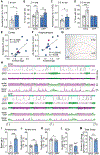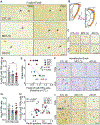Restoring activity in the thalamic reticular nucleus improves sleep architecture and reduces Aβ accumulation in mice
- PMID: 34731016
- PMCID: PMC8985235
- DOI: 10.1126/scitranslmed.abh4284
Restoring activity in the thalamic reticular nucleus improves sleep architecture and reduces Aβ accumulation in mice
Erratum in
-
Erratum for the Research Article "Restoring activity in the thalamic reticular nucleus improves sleep architecture and reduces Aβ accumulation in mice" by R. Jagirdar et al.Sci Transl Med. 2024 Feb 7;16(733):eado1402. doi: 10.1126/scitranslmed.ado1402. Epub 2024 Feb 7. Sci Transl Med. 2024. PMID: 38324642 No abstract available.
Abstract
Sleep disruptions promote increases of amyloid β (Aβ) and tau in the brain and increase Alzheimer’s disease (AD) risk, but the precise mechanisms that give rise to sleep disturbances have yet to be defined. The thalamic reticular nucleus (TRN) is essential for sleep maintenance and for the regulation of slow-wave sleep (SWS). We examined the TRN in transgenic mice that express mutant human amyloid precursor protein (APP) and found reduced neuronal activity, increased sleep fragmentation, and decreased SWS time as compared to nontransgenic littermates. Selective activation of the TRN using excitatory DREADDs restored sleep maintenance, increased time in SWS, and reduced amyloid plaque load in both hippocampus and cortex. Our findings suggest that the TRN may play a major role in symptoms associated with AD. Enhancing TRN activity might be a promising therapeutic strategy for AD.
Figures





References
Publication types
MeSH terms
Substances
Grants and funding
LinkOut - more resources
Full Text Sources
Medical
Molecular Biology Databases

